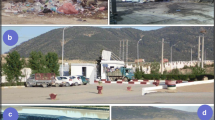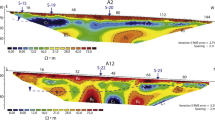Abstract
Waste management is one of the most important problems in developing countries. The major concern in this regard is waste dump sites, to both environmental scientists and the general public. At Al Misk (Buraiman) Lake, all the domestic and industrial waste of Jeddah was dumped without any treatment. A concrete dam was constructed to block the migration of contaminants from the lake. The purpose of this research is to determine the efficiency of geophysical methods in delineating the contaminant emanating from the seepage of sewage water from Al Misk Lake to the wadi downstream of the concrete dam. The geophysical studies are used, including the electrical resistivity and induced polarization techniques in conjunction with in-situ hydrogeological studies to define the extension of contamination in both sides of the dam. Two subsurface layers were identified by geophysical techniques. The most of the contamination is restricted in the first layer which is interpreted as a salty sandy layer with high porosity. The average thickness of contaminated layer is about 8 m and has very low resistivity (<10 Ω.m) due to the increase of contaminated water. The second layer shows the relative high resistivity values (>30 Ω.m) than the first layer due to the presence of boulders and gravels with silty sand and, in some places, accumulation of basement boulders also found with high resistivity values (>700 Ω.m). Induced polarization helps to differentiate between the clay and contaminated sandy layer due to the variation of their chargeability values. Induced polarization results show the presence of low resistivity and low chargeability values in the first layer and high chargeability in some parts of the second layer duo to the presence of clay. The contaminations may extend to the deep layers, in the areas of faults and more porosity sediments. The results of electrical conductivity (EC), total dissolved solids analysis, temperature, and pH reveal that the total dissolved solids are very high in the front and the back of the dam, which affect the other parameters. The results concluded that the contaminant plume exists on either side of the dam with the same degree of contamination.










Similar content being viewed by others
References
Abdullah N, Osazuwa I, PO S (2011) Application of integrated geophysical techniques in the investigation of groundwater contamination: a case study of municipal solid waste leachate. Ozean J Appl Sci 4(1)
Adepelumi A, Solanke A, Sanusi O, Shallangwa A (2006) Model tank electrical resistivity characterization of LNAPL migration in a clayey-sand formation. Environ Geol 50(8):1221–1233
Aristodemou E, Thomas-Betts A (2000) DC resistivity and induced polarisation investigations at a waste disposal site and its environments. J Appl Geophys 44(2):275–302
Bahkaly IM, El-Waheidi MM, Jallouli C, Batayneh AT (2015) Assessment of shallow aquifer salinity in the Aqaba Coastal plain using ERT method: a case study of Maqnah region, northwestern Saudi Arabia. Environ Earth Sci 74:2105–2114
Benson AK, Payne KL, Stubben MA (1997) Mapping groundwater contamination using DC resistivity and VLF geophysical methods—a case study. Geophys 62(1):80–86
Buselli G, Lu K (2001) Groundwater contamination monitoring with multichannel electrical and electromagnetic methods. J Appl Geophys 48(1):11–23
Chandrasekhar E, Ramesh D, Gurav T, Biswal T (2014) Assessment of groundwater salinity in Nellore district using multi-electrode resistivity imaging technique. J Earth Syst Sci 123(8):1809–1817
Choudhury K, Saha D (2004) Integrated geophysical and chemical study of saline water intrusion. Ground Water 42(5):671–677
Dahlin T (2012) Application of resistivity-IP to mapping of groundwater contamination and buried waste. Geophysical Association of Ireland, Dublin, 6pp
Deceuster J, Chaballe M, Kaufmann O (2005) 3D resistivity and IP tomography as efficient tools to monitor remedial actions over a gas plume. In: Proceedings 18th EEGS Symposium on the Application of Geophysics to Engineering and Environmental Problems2005, p. 155–166
Ekeocha N, Okereke ID, Okonkwo S (2012) Electrical resistivity investigation of solid waste dumpsite at Rumuekpolu in Obio Akpor LGA, Rivers State, Nigeria. Int J Sci Technol 1(11):631–637
Elfeki A, Ewea H, Al-Amri N (2011) Linking groundwater flow and transport models, GIS technology, satellite images and uncertainty quantification for decision making: Buraiman Lake Case Study Jeddah, Saudi Arabia. Int J Water Res Arid Environ 1(4):295–303
Ewea H (2010) Hydrological analysis of flooding wastewater lake in Jeddah: Saudi Arabia. Journal of King Abdel Aziz Univ: Met., Env. &. Arid Land Agric Faculty 21(9):125–144
Gazoty A, Fiandaca G, Pedersen J, Auken E, Christiansen A, Pedersen J (2012) Application of time domain induced polarization to the mapping of lithotypes in a landfill site. Hydrol Earth Syst Sci 16(6):1793–1804
Keller G, Tasci M, Jordan J (1996) Electromagnetic imaging for indirect detection of hydrocarbons: a discovery. SEG Tech Program Expanded Abstracts 1996:226–229
Khaki M, Yusoff I, Islami N (2014) Groundwater quality assessment of a freshwater wetland in the Selangor (Malaysia) using electrical resistivity and chemical analysis. Water Sci Technol: Water Supply 14(2):255–264
Loke M (2001a) Tutorial: 2-D and 3-D electrical imaging surveys. Geotomo Software, Malaysia
Loke, M (2001b) Tutorial: 2-D and 3-D electrical imaging surveys. Penang, Malaysia, University of Sains Malaysia: Unpublished course notes, http://www. geoelectric. com
Loke M (2004) Tutorial: 2-D and 3-D electrical imaging surveys. Geotomo Software, Malaysia
McDowell P, Barker RD, Butcher A, Culshaw M, Jackosn P, McCann D, Skipp B, Matthews S, Arthur J (2002) Geophysics in engineering investigations, Ciria, 260
Milsom J (2007) Field geophysics. John Wiley and Sons, Chichester
Moore T, Al-Rehaili M (1989) Geologic map of the Makkah Quadrangle: sheet 21D. Ministry of Petroleum and Mineral Resources, Deputy Ministry For Mineral Resources Publication, Jeddah, SA, Kingdom of Saudi Arabia
Oduduru PI, Mamah LI (2014) Integration of electrical resistivity and induced polarization for subsurface imaging around the Pond, Nsukka, Anambra Basin, Nigeria. Pacific J Sci Technol 15(1):306–317
Osella A, de la Vega M, Lascano E (2002) Characterization of a contaminant plume due to a hydrocarbon spill using geoelectrical methods. J Environ Eng Geophys 7(2):78–87
Pierwola J (2013) Investigation of soil contamination using resistivity and induced polarization methods. Polish J Environ Stud 22(6):1781–1788
Rapaport D (1995) Sewage pollution in Pacific island countries and how to prevent it. Center for Clean Development, Eugene
Samouëlian A, Cousin I, Tabbagh A, Bruand A, Richard G (2005) Electrical resistivity survey in soil science: a review. Soil Tillage Res 83(2):173–193
Seigel HO (1959) Mathematical formulation and type curves for induced polarization. Geophys 24(3):547–565
Sidhardhan S, Adishkumar S, Jayganesh D (2015) A geophysical investigation of resistivity and groundwater quality near a corporate solid waste dump.
Slater LD, Sandberg SK (2000) Resistivity and induced polarization monitoring of salt transport under natural hydraulic gradients. Geophys 65(2):408–420
Soupios P, Papadopoulos I, Kouli M, Georgaki I, Vallianatos F, Kokkinou E (2007a) Investigation of waste disposal areas using electrical methods: a case study from Chania, Crete, Greece. Environ Geol 51(7):1249–1261
Soupios P, Papadopoulos N, Papadopoulos I, Kouli M, Vallianatos F, Sarris A, Manios T (2007b) Application of integrated methods in mapping waste disposal areas. Environ Geol 53(3):661–675
Srinivasamoorthy K, Sarma V, Vasantavigar M, Vijayaraghavan K, Chidambaram S (2009) Electrical imaging techniques for groundwater pollution studies: a case study from Tamil Nadu state, South India. Earth Sci Res J 13(1):30–39
Storz H, Storz W, Jacobs F (2000) Electrical resistivity tomography to investigate geological structures of the earth’s upper crust. Geophys Prospect 48(3):455–472
Ustra AT, Elis VR, Mondelli G, Zuquette LV, Giacheti HL (2012) Case study: a 3D resistivity and induced polarization imaging from downstream a waste disposal site in Brazil. Environ Earth Sci 66(3):763–772
WWDR U (2003) Water for people, water for life. UNESCO Publishing, Paris
WWDR U (2009) The United Nations world water development report 3. Earthscan, London
Zogala B, Robak M, Dubiel R, Zuberek W, Steininger M, Wzientek K (2009) Geoelectrical methods for detection of oil contaminations in soils and bioremediation process monitoring. In: Proceedings 22nd Symposium on the Application of Geophysics to Engineering and Environmental Problems 2009, SAGEEP 2009, Volume 1, p 348–362
Author information
Authors and Affiliations
Corresponding author
Rights and permissions
About this article
Cite this article
Rehman, F., Abuelnaga, H.S.O., Harbi, H.M. et al. Using a combined electrical resistivity imaging and induced polarization techniques with the chemical analysis in determining of groundwater pollution at Al Misk Lake, Eastern Jeddah, Saudi Arabia. Arab J Geosci 9, 286 (2016). https://doi.org/10.1007/s12517-016-2423-9
Received:
Accepted:
Published:
DOI: https://doi.org/10.1007/s12517-016-2423-9




